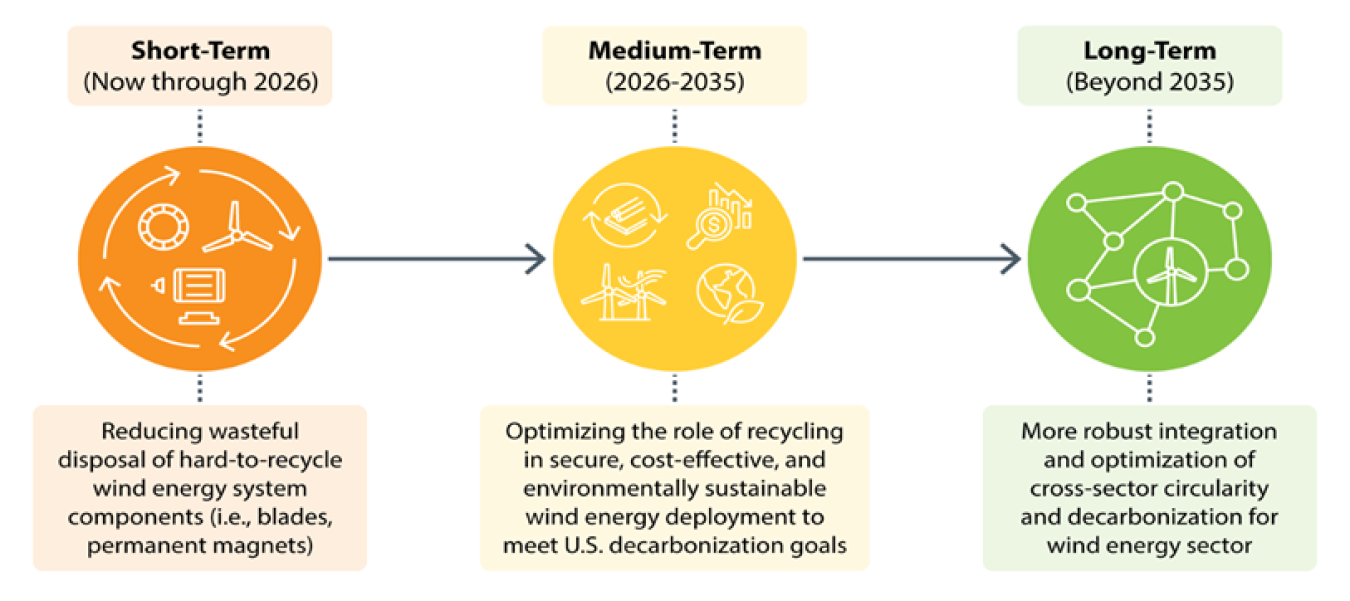
The U.S. Department of Energy's (DOE's) Wind Energy Technologies Office and its partners are working to develop efficient, cost-effective, and environmentally responsible ways to manage the volume of decommissioned wind turbine materials. DOE's National Renewable Energy Laboratory, Oak Ridge National Laboratory, and Sandia National Laboratories provide research, development, and demonstration investment recommendations to inform the Wind Energy Recycling Research, Development, and Demonstration program, which is funded by the Bipartisan Infrastructure Law.
Today, approximately 90% of the mass of wind turbines and wind systems can be recycled. The Wind Energy Tech Recycling Research & Development program aims to create innovative and practical approaches to increase the reuse and recycling of wind energy technologies. Reuse and recycling activities can help mitigate wind energy's impact on national resources, as increased wind energy technology deployment influences demand for raw and processed materials, including critical materials vulnerable to supply disruption. Transitioning the U.S. wind industry into a circular, resource-conserving economy will help reduce material supply chain vulnerabilities, conserve U.S. resources, and increase the sustainability of the wind energy sector.
To support this transition, research conducted between multiple national labs through collaborative assessments help WETO understand how alternative materials, designs, and manufacturing processes might enable more efficient, cost-effective, and environmentally responsible disassembly of and resource recovery from wind energy technologies. This research includes:
- Evaluating current industry practices
- Assessing the research, development, and demonstration landscape, including cross-sector opportunities
- Identifying opportunities for emerging technologies (e.g., by engaging with the broader scientific community, including universities, industry, national labs, and other research institutes).
Additional objectives include establishing metrics that can be used to compare technologies and inform recommendations for future research funding. This effort includes providing data to DOE that will guide high-impact, high-priority research and development needs in the U.S. wind energy industry, as well as information to support community engagement and outreach.
Recycling Wind Energy Systems in the United States
Part 1: Providing a Baseline for America’s Wind Energy Recycling Infrastructure for Wind Turbines and Systems
For this report, a team of researchers at DOE's National Renewable Energy Laboratory, Oak Ridge National Laboratory, and Sandia National Laboratories performed a comprehensive life cycle and techno-economic assessment of end-of-life management pathways of U.S. wind turbines and systems. They evaluated the technical, environmental, and economic indicators for different materials, designs, and recycling technologies.
The research shows that the United States could maximize the recyclability of wind turbines by:
- Improving end-of-life decommissioning and sorting practices
- Ensuring strategic siting of recycling facilities
- Expanding and improving recovery and recycling infrastructure
- Substituting hard-to-recycle or critical materials with more easily separable and affordable materials, or improved component designs and manufacturing techniques
- Developing of modular component designs
- Optimizing properties of recovered materials for second-life applications
- Ensuring greater access for the U.S. recycling infrastructure to utilize waste streams from the wind energy sector, and the equipment required to disassemble wind energy components.
One possible step to improve recycling for utility-scale energy systems is to increase the dedicated infrastructure needed to recycle the anticipated volume of fiber-reinforced composites in blades and the rare-earth materials and electrical steel found in turbine generators. Another step is to develop more reliable high-performance power electronic devices, such as inverters to extend their lifespans.
In addition to reducing emissions related to the recycling process, these measures could also reduce recycling costs, boost the U.S. economy, and position the United States to be a world leader in environmental sustainability. In addition, by increasing and verifying the quality of recycling outputs, the U.S. wind energy industry could help raise consumer confidence in upcycled products.
Short-, medium-, and long-term research, development, and demonstration investment recommendations along the life cycle of wind energy systems are also provided in support of these findings.
Additional Information
- Download the full report
- Read the DOE announcement
- Visit the Wind Turbine Sustainability Page to learn more about how DOE is improving wind energy recycling.
Readers note: Future reports focusing on a deeper dive into wind turbine recyclability, stakeholder engagement, and distributed wind recycling will be released soon.

